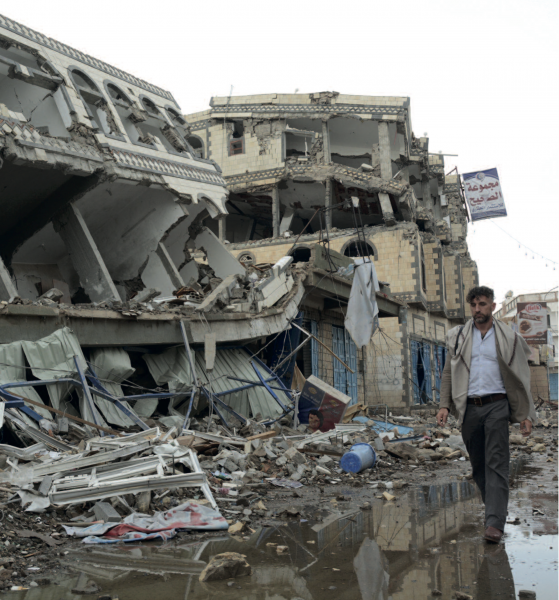With states meeting in Vienna this week for discussions aimed at better protecting civilians from bombing and bombardment in towns and cities, new reports from INEW members (linked below) emphasise the urgency of addressing the predictable, preventable and unacceptable harm to civilians caused by the use of explosive weapons in populated areas. States must develop an international commitment on this issue to help protect civilians, notably by ending the use of explosive weapons with wide area effects in populated areas.

The city of Sa’ada has been heavily hit by airstrikes during the conflict in Yemen in 2015 (Philippe Krops/OCHA)
Yemen: the country worst affected by explosive weapons so far in 2015
In ‘State of crisis: Explosive weapons in Yemen’ Action on Armed Violence (AOAV) and the UN Office for the Coordination of Humanitarian Affairs (OCHA) investigate the humanitarian impact of the use of explosive weapons in populated areas in Yemen up to 31 July 2015. The report uses data from AOAV’s explosive violence survey (based on English-language media reports) and the stories and testimonies of people living through the violence in Yemen to look at the devastating impacts of the use of explosive weapons in populated areas for civilians – both immediately and in the longer term. 5,239 deaths and injuries from explosive weapon use were recorded by AOAV during January-July 2015, the vast majority of whom were civilians. When explosive weapons were used in populated areas, civilians made up 95% of reported deaths and injuries. More civilian deaths and injuries from explosive weapons were recorded in Yemen during the first seven months of 2015 than in any other country in the world.
Ukraine: testimonies and images
In June 2015, PAX and UN OCHA travelled to both Government Controlled Areas and Non-Government Controlled Areas in Ukraine to speak to people living through the conflict about how the use of explosive weapons in towns and cities has made an impact, and continues to make an impact, on their lives. Their report ‘Collateral: The human cost of explosive violence in Ukraine‘, accompanied by photographs from Dirk-Jan Visser, documents the devastating and predictable pattern of harm that occurs whenever explosive weapons are used in populated areas.
Libya: trends in explosive weapons use and the devastating impact on civilians since 2011
Violence and conflict in Libya since February 2011 have had a grave impact on the civilian population. In particular, the widespread use of explosive weapons by Government forces and armed groups in cities, towns and villages has resulted in the death and injury of thousands of civilians, destroyed livelihoods and essential infrastructure, and forced tens of thousands of people to flee their homes. A new briefing paper from PAX and UN OCHA, ‘Shattered lives: Civilians suffer from the use of explosive weapons in Libya‘ illustrates the heavy price that civilians have paid for the explosive violence in Libya through personal accounts of victims and their families.
Humanitarian consequences beyond the immediate casualties
Explosive weapons inflict severe consequences on affected communities beyond the casualties they case: they trigger humanitarian crises, amplify social inequalities, inflict psychological trauma, and can have economic impacts on communities for decades. In their new paper ‘Hidden Victims: Additional Humanitarian Consequences of Explosive Weapons Use‘, Mines Action Canada argues that as the international community addresses the humanitarian effects of explosive weapons, it is vitally important that they consider these broader impacts of explosive weapons use.
